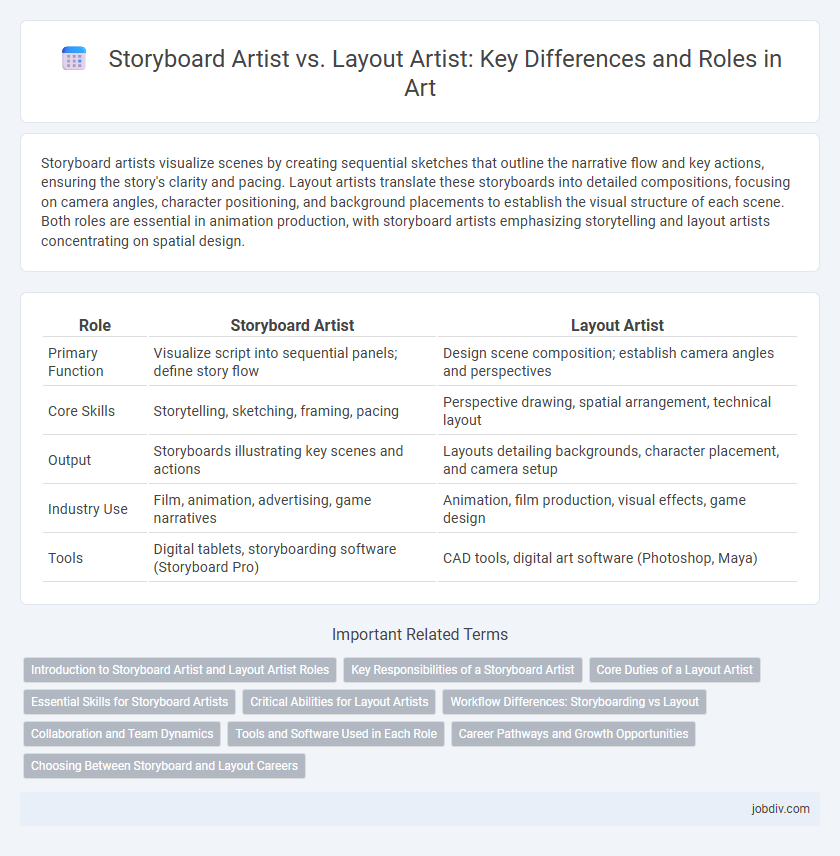Storyboard artists visualize scenes by creating sequential sketches that outline the narrative flow and key actions, ensuring the story's clarity and pacing. Layout artists translate these storyboards into detailed compositions, focusing on camera angles, character positioning, and background placements to establish the visual structure of each scene. Both roles are essential in animation production, with storyboard artists emphasizing storytelling and layout artists concentrating on spatial design.
Table of Comparison
| Role | Storyboard Artist | Layout Artist |
|---|---|---|
| Primary Function | Visualize script into sequential panels; define story flow | Design scene composition; establish camera angles and perspectives |
| Core Skills | Storytelling, sketching, framing, pacing | Perspective drawing, spatial arrangement, technical layout |
| Output | Storyboards illustrating key scenes and actions | Layouts detailing backgrounds, character placement, and camera setup |
| Industry Use | Film, animation, advertising, game narratives | Animation, film production, visual effects, game design |
| Tools | Digital tablets, storyboarding software (Storyboard Pro) | CAD tools, digital art software (Photoshop, Maya) |
Introduction to Storyboard Artist and Layout Artist Roles
Storyboard artists visualize scripts by creating sequential sketches that map out scenes and camera movements, ensuring narrative flow and pacing for films or animations. Layout artists translate these storyboards into detailed scene compositions, establishing precise character positions, backgrounds, and lighting to guide production teams. Both roles demand strong artistic skills and a deep understanding of storytelling, but storyboard artists focus on conceptualizing scenes while layout artists handle technical scene execution.
Key Responsibilities of a Storyboard Artist
Storyboard artists are responsible for visualizing the script by creating sequential sketches that outline the narrative flow, character actions, and key scenes. They interpret the director's vision to establish pacing, camera angles, and shot composition, ensuring the story is effectively communicated before production begins. Their work serves as a blueprint for animators and cinematographers, bridging the gap between concept and final visual output.
Core Duties of a Layout Artist
Layout artists are responsible for designing the visual structure of scenes, including camera angles, staging, and character placement, ensuring fluid storytelling and composition. They translate storyboard sketches into detailed layouts that guide animators and background artists during production. Their core duties also include maintaining spatial continuity and perspective to create immersive environments that enhance narrative flow.
Essential Skills for Storyboard Artists
Storyboard artists must possess strong storytelling abilities, keen attention to visual composition, and proficiency in drawing to effectively convey narrative flow. Mastery of timing, pacing, and shot variety is essential to translate scripts into dynamic visual sequences. Unlike layout artists who focus on scene staging and camera angles, storyboard artists prioritize narrative clarity and emotional impact through sequential art.
Critical Abilities for Layout Artists
Layout artists must excel in spatial awareness, perspective drawing, and composition to effectively translate storyboards into visual blueprints for animation or film. Mastery of camera angles, lighting placement, and scene continuity ensures seamless narrative flow and immersive environments. Proficiency in digital tools like Photoshop and 3D modeling software enhances precision and adaptability in creating dynamic layouts.
Workflow Differences: Storyboarding vs Layout
Storyboard artists develop sequential panels that visualize key scenes and actions, establishing the narrative flow and timing for a project. Layout artists translate these storyboards into detailed background and camera setups, defining composition, perspective, and spatial relationships within each scene. The workflow difference lies in storyboarding focusing on storytelling and scene pacing, while layout emphasizes technical framing and environmental design for animation or film production.
Collaboration and Team Dynamics
Storyboard artists and layout artists collaborate closely to translate scripts into visual narratives, with storyboard artists focusing on scene composition and pacing while layout artists design precise camera angles and character placements. Effective team dynamics require clear communication and mutual understanding of each role's contribution to maintain narrative consistency and optimize workflow efficiency. This collaboration ensures a seamless transition from conceptual sketches to final animation, enhancing overall artistic quality and storytelling impact.
Tools and Software Used in Each Role
Storyboard artists primarily utilize digital drawing tools such as Adobe Photoshop, Storyboard Pro, and Clip Studio Paint to create detailed visual narratives and frame-by-frame sketches. Layout artists frequently work with software like Autodesk Maya, Adobe After Effects, and Harmony to design scene composition, camera angles, and integrate backgrounds with character placements. Both roles depend heavily on industry-standard tools tailored for pre-visualization and animation pipeline efficiency.
Career Pathways and Growth Opportunities
Storyboard artists specialize in visual narrative development, laying out scenes to guide film or animation production, often advancing into directing or creative lead roles due to their storytelling expertise. Layout artists focus on scene composition, camera angles, and lighting setups, which can lead to careers in production design or art direction given their technical and spatial skills. Both roles offer growth through collaboration across departments, with increasing demands for digital proficiency and cross-disciplinary knowledge driving opportunities in emerging media formats.
Choosing Between Storyboard and Layout Careers
Storyboard artists specialize in visual storytelling, creating sequential sketches that map out scenes for films or animations. Layout artists focus on designing the composition of each shot, determining camera angles, lighting, and character placements to enhance the narrative flow. Choosing between these careers depends on whether you prefer conceptual storytelling through sequential drawings or technical composition and spatial planning within a scene.
Storyboard Artist vs Layout Artist Infographic

 jobdiv.com
jobdiv.com